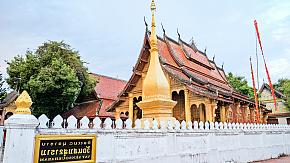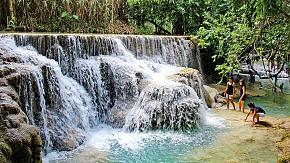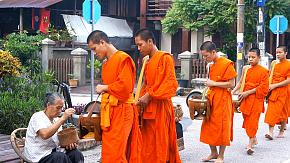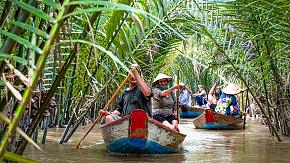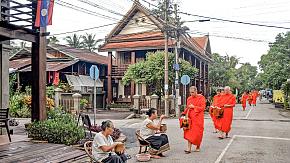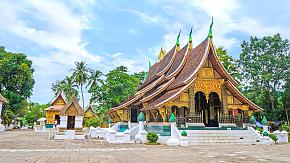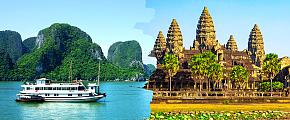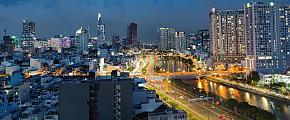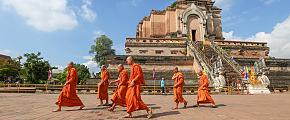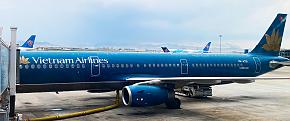Highlights of a Laos Tour: Royal Palace, Alms-Giving Ceremony
The only landlocked country in Southeast Asia, Laos is a hidden gem often overlooked by travelers to its more popular neighbors, Vietnam, Thailand, and Cambodia. In fact, Laos has no lack of vibrant culture, fascinating history, and spectacular scenery. So, I've picked some of the most amazing experiences of Laos, in the hope that you can embark on a trip to explore this largely untouched land.
- Visit the Royal Palace Museum
- Witness the Alms-Giving Ceremony
- Swim in the Pools of Kuang Si Waterfalls
- Cruise the Mekong River
- Enjoy Slow-Paced Life in Si Phan Don
- Admire the Beauty of Wat Xieng Thong
- Hike up Mount Phou Si
- Shop at Luang Prabang Night Market
- Discover the Mysterious Plain of Jars
- Marvel at Laos' Holiest Shrine - Pha That Luang
- Experience the life of a Laotian Farmer's Life
Visit the Royal Palace Museum
Once the residence of the Laotian royal family, the Royal Palace Museum in Luang Prabang, also known as Haw Kham (literally "golden hall"), is a wonderful place to learn about the history and culture of Laos.
The palace was built for King Sisavang Vong and his family in 1904 during the French occupation to replace the former wooden palace. After the monarchy was overthrown by the communist forces in 1975, it was turned into a museum. It dominates the main street of Luang Prabang, sitting on the bank of Mekong River and facing Mount Phou Si. The site was specially chosen so that official visitors could be received once they got off the ship on the Mekong.
The palace was designed by the French, infusing Beaux-Arts and traditional Lao architectural styles. It contains a wealth of historical art and relics important to the Laotians, such as the crown jewels, religious artifacts, statues, weaponry, gifts given by foreign visitors, paintings depicting scenes of daily life in the 1930s, etc. The residential quarters remain much the same as they were when the royal family left the palace. A visit to their rooms offers an insight into their lifestyle. There's a separate building that houses a collection of cars of the last Lao king. At Wat Ho Pha Bang, which is located in the southeast corner of the palace grounds, you can find the sacred Pha Bang image, from which Luang Prabang gets its name.
The Royal Palace Museum opens every day from 8 am to 11:30 am and 1:30 to 4 pm. Photography and footwear are prohibited inside the museum, and bags must be stored in a locker room beside the main entrance.
Witness the Alms-Giving Ceremony
The Laotians show great reverence for Buddhist monks and giving alms is a common part of their daily life. Before dawn, hundreds of saffron-robed barefoot monks walk in single file down the streets of Luang Prabang to collect alms from locals. This centuries-old ritual is all done in silence and takes place every morning. It is really a sight to behold. Don't miss it while in Luang Prabang.
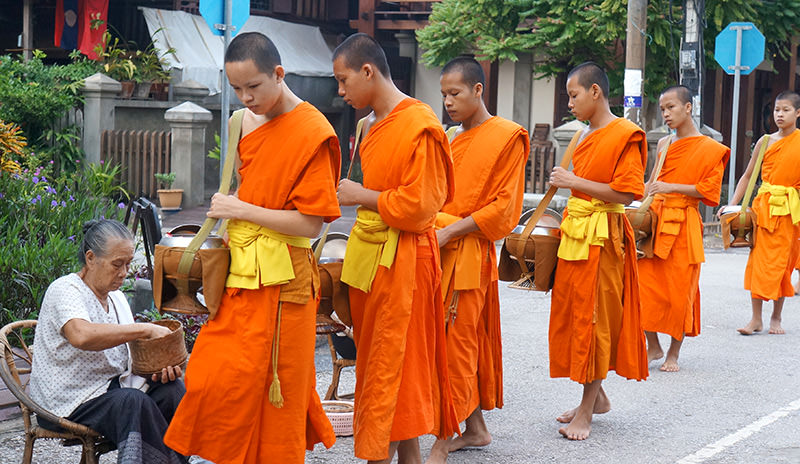 Alms-Giving Ceremony in Luang Prabang
Alms-Giving Ceremony in Luang Prabang
If you want to watch the ceremony, you may find these tips helpful.
1) Dress conservatively. Wear clothes that keep your shoulders and legs covered.
2) Keep a respectful distance. Do not get in the way of the monks or the alms-givers.
3) If you take photos, do not use the camera flash.
4) Don't make eye contact with the monks, as this may disturb their meditation.
Swim in the Pools of Kuang Si Waterfalls
Seeing cascades of white water running from the thick jungle down into the tiered turquoise pools is absolutely one of the most amazing things to do in Laos. Just 30 km / 19 mi outside Luang Prabang, you'll find the strikingly beautiful Kuang Si Waterfalls surrounded by trees.
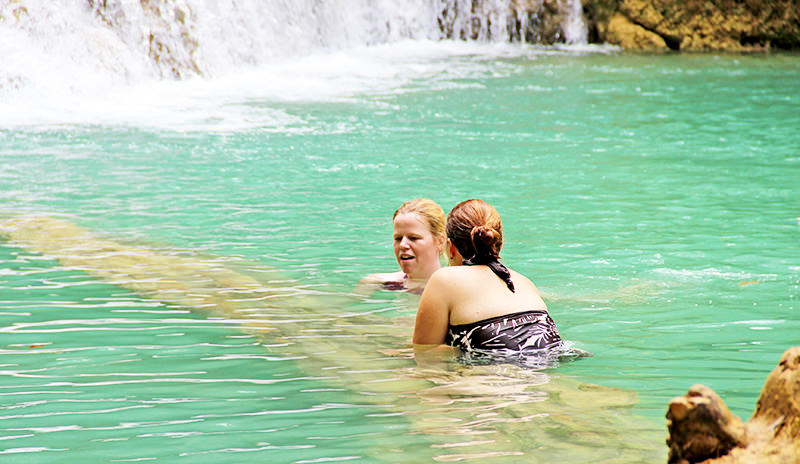 Kuang Si Waterfalls
Kuang Si Waterfalls
Take a dip into the pool and relax. Changing rooms can be found at pools near the picnic area and there are swinging ropes from which you can jump into the pool. You might also like to hike to the top where you can get epic views of the fall and the breathtaking Lao countryside.
If you are interested in wildlife, you may like to stop at Tat Kuang Si Bear Rescue Centre to see wild Asiatic Moon bears that are saved from poachers, before arriving at the waterfall.
Tips:
1) Kuang Si opens daily from 8 am to 5: 30 pm.
2) Note that you are not allowed to swim in some pools because the locals consider them to be sacred. Just pay attention to the signs that say "no swimming".
3) December through May is the best time to visit Kuang Si Waterfall. This is also the high season, so be sure to arrive early to enjoy some quiet time.
4) Remember to apply some sunscreen as sun rays can go through even lush forest.
Cruise the Mekong River
The mighty Mekong is the lifeline of Laos. You'll see it whether you're in Luang Prabang, Vientiane or Pakse. Traveling by boat on the Mekong is the most relaxing way to explore the untouched landscape of the country, and get a glimpse into the rural life of secluded villages - fishermen casting nets, water buffaloes sunbathing on sand banks, kids playing on the shore, etc.
There is an array of options available, from just a few hours' excursions to multi-day luxury cruises. One of Laos' most popular Mekong River cruises is a two-day journey from Huay Xay, a town on the border with Thailand, to Luang Prabang (or vice versa). Many travelers also like to take a boat trip to see villages around Luang Prabang and explore the famous Pak Ou Caves which overlook the Mekong and are home to thousands of Buddha statues of various sizes and poses.
Enjoy Slow-Paced Life in Si Phan Don (4,000 Islands)
Si Phan Don or the 4,000 Islands is the ultimate place to relax and rejuvenate. This archipelago is found in the Mekong River in the Champasak province in southern Laos. Time seems to stand still here and postcard-worthy views are everywhere. During dry months, one can find thousands of islets and sandbars though nearly half of them are submerged during monsoon season.
There are three major islands that are popular with tourists, including Don Khong, Don Det and Don Khon, each with different personalities. Don Dhet is the most popular island, with a party-friendly vibe. Don Khon is a bit quieter and more luxurious. Don Khong is the largest island and also the least crowded. It is more laid back. You can not only laze on the beautiful beach and watch the sunset, but also have the opportunity to experience the slow-paced rural life by exploring lovely fishing villages, serene peaceful monasteries, and lush vegetation.
Admire the Beauty of Wat Xieng Thong
The UNESCO World Heritage-listed town of Luang Prabang has some of the most beautiful temples in Laos. Wat Xieng Thong ("Temple of the Golden City"), sitting on the bank of Mekong River, is a must-visit. It is one of the country's oldest temples, built in the 16th century by King Setthahirath and was a royal temple where the kings of Laos were crowned until 1975 when the Lao People's Democratic Republic was founded.
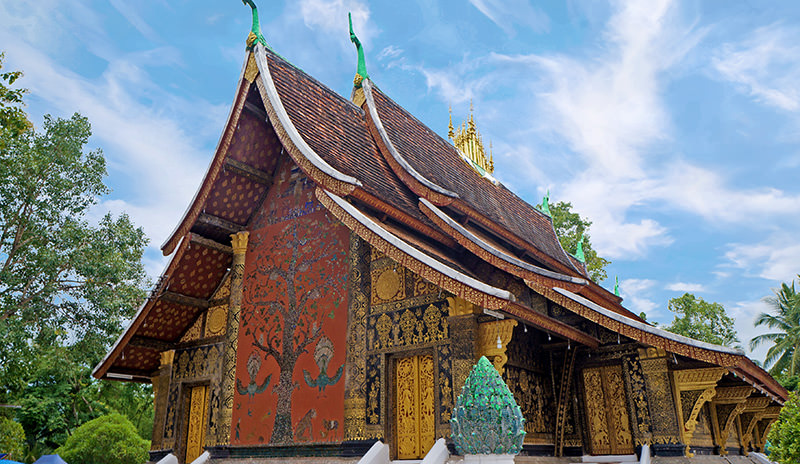 Wat Xieng Thong's "tree of life"
Wat Xieng Thong's "tree of life"
The temple is richly decorated, with three-tiered roof sweeping down almost to the ground. On the western exterior wall is a fascinating "tree of life" mosaic. Also worth observing is the great detail on and in the buildings. Take your time to wander around and soak up the beauty and serenity.
Wat Xieng Thong opens daily from 8 am to 5 pm. It is located at the northern tip of Luang Prabang. Please be respectful if you visit the temple. Be sure to cover your knees and shoulders, and take off your hat and shoes.
Hike up Mount Phou Si for Mesmerizing Views of Luang Prabang
Soaring 100 meters / 328 feet above the ground in the center of Luang Prabang, Mount Phou Si (literally "sacred hill") is the best place to admire the beautiful skyline of the sleepy town. Reaching the summit requires a climb of an approximately 350-step staircase (about 20 minute-hike), and anyone reasonably fit can do it. Along the way, you'll find statues and shrines. Once you're on the top, you can walk around and get a 360-degree view of the city and the surrounding area. There's a gilded stupa called That Chomsi that crowns the summit, which is also worth admiring.
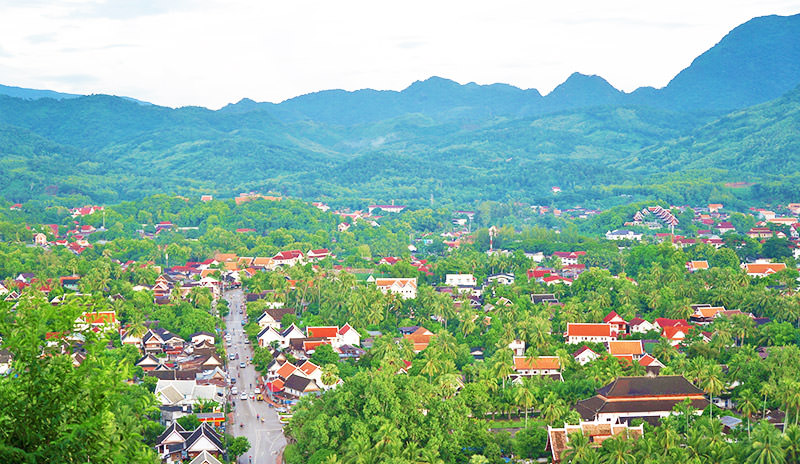 A stunning view of Luang Prabang from Mount Phou Si
A stunning view of Luang Prabang from Mount Phou Si
Mount Phou Si is best visited at dawn or sunset to absorb the views. It's a popular spot to watch the sunset and can be particularly crowded. So make sure you go early and arrive about an hour before the sun goes down.
Shop at Luang Prabang Night Market
Luang Prabang Night Market is one of the most charming markets in Laos. Every evening, a stretch of Sisavangvong Road that runs through the town center is blocked to traffic and turned into a shopping paradise. Hill-tribe traders and local vendors line the street with colorful products they bring, including silk scarves, clothing, bags, wood carvings, ceramics, antiques, silver, jewelry, bamboo lamps, and other knickknacks.
Hard selling is uncommon and prices are usually reasonable. If you are hungry or just want to try some local food, head to one of the side streets packed with food stalls. You'll find roasted meats, Lao sausages, coconut pancakes, fruit shakes, and other local favorites.
The Night Market opens every night from 5 pm to 10 pm, at Sisavangvong Road, starting at the post office and ending after the National Museum.
Discover the Mysterious Plain of Jars
In the province of Xiang Khouang in central Laos lies one of the most mysterious archaeological sites on earth - the Plain of Jars which date back to the Iron Age, about 500 BC. Miles of grassy plain is scattered with thousands of large stone jars. In 2019, the Plain of Jars was listed as a UNESCO World Heritage Site.
Despite the best efforts made, no one clearly knows the origin and reason for these jars. The local people think they were used to ferment Laotian rice whisky while leading theory claims that they were once for holding human remains. It is also believed that they were used to collect rainwater.
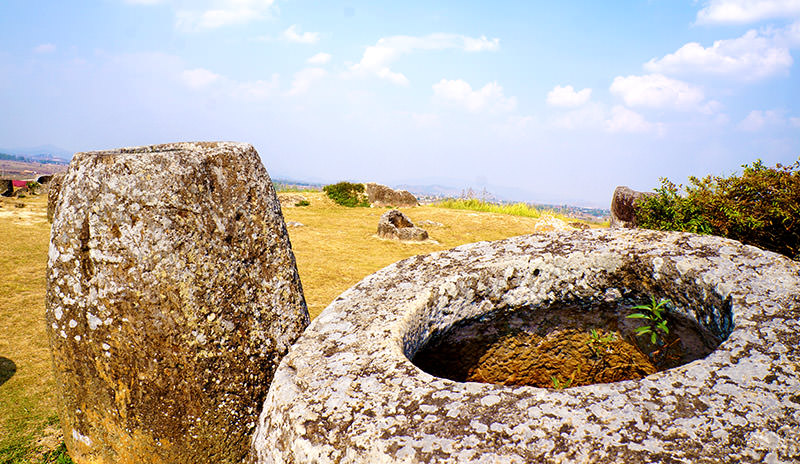 The Plain of Jars
The Plain of Jars
Conducting research is slow and can be dangerous since a large number of unexploded objects dropped during the Vietnam War by the US are still here. Currently, 12 of the 90 numbered sites have been cleared of UXOs and are safe to visit. Site 1 is the most popular as it is close to the town of Phonsavan, the capital of Xiang Khouang Province. It is where you can marvel at the largest "King Jar". At Site 2, you'll find the longest jar.
Marvel at Laos' Holiest Shrine - Pha That Luang
Pha That Luang ("Great Sacred Stupa") is a majestic gold-covered Buddhist stupa, located just 4 km / 2.5 mi northeast of the city center of Vientiane, Laos' capital. It is the country's most important Buddhist monument and a symbol of Lao sovereignty. You can see the image of the stupa on Lao Kip, the currency of Laos, as well as on government logos. This is also where Boun That Luang, Lao's most important Buddhist festival is held.
It's believed that Pha That Luang dates from as early as the 3rd century BC when the Indian emperor Ashoka the Great sent out missionaries to build a stupa in the Vientiane area to enshrine a piece of Buddha's breastbone. Erected in the 16th century, the current stupa was destroyed in the 19th century by the Siamese and rebuilt by the French in the 1930s according to the original design. Adding importance to this already sacred spot are the remains of a 12-century Khmer temple.
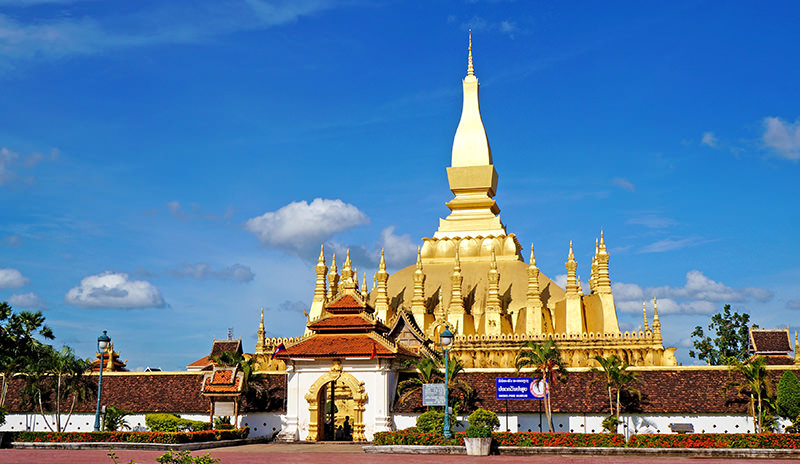 Pha That Luang
Pha That Luang
The golden stupa is 45 meters / 148 feet high and surrounded by a cloister with small windows. On the inside of the cloister walls are various Buddhist images, including a statue of Jayavarman VII, king of the Khmer Empire in the modern-day Siem Reap, Cambodia. There are many other Buddhist structures in the extensive grounds of Pha That Luang, such as the large golden reclining Buddha.
You can walk around the grounds, admire the glittering stupa and other structures, soak up the relaxed ambiance, and may even have the chance to chat with a monk. Pha That Luang opens from 8 am till noon and 1 pm to 4 pm. It's suggested you visit early to avoid the crowds.
Get a Taste of a Laotian Farmer's Life in the Living Land Farm
Nothing is quite like spending half a day in the Living Land Farm set in the idyllic countryside, just a short drive from the town of Luang Prabang. It is one of the most unique and coolest things to do in Laos and surely unmissable. Here you will get hands-on experience of how rice, the staple of Laos, is produced, from selecting the seeds to growing and harvesting, all in an educational and enjoyable way. The highlight is working with a water buffalo to plow a rice paddy. In the end, you'll gain a fantastic insight into what it is like to be a Laotian farmer.
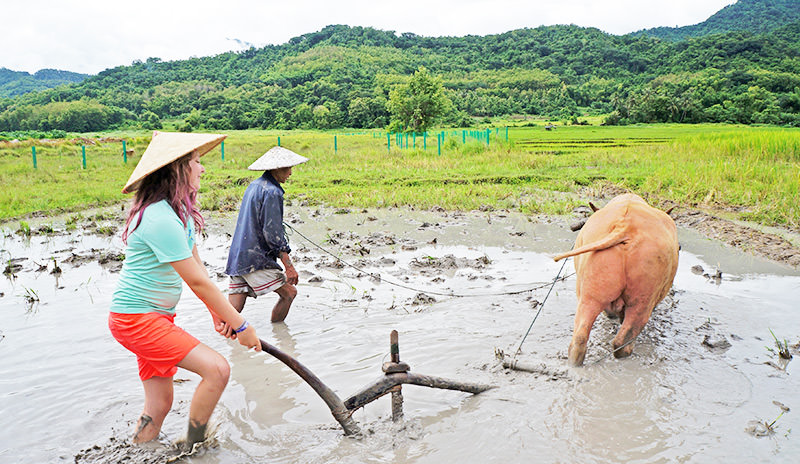 Plowing the rice paddy with a water buffalo can be fun
Plowing the rice paddy with a water buffalo can be fun
The Living Land Farm is a community enterprise established to support the local community and supplies leading restaurants in Luang Prabang with organic rice, vegetables, and herbs. It is about 5 km outside the town of Luang Prabang, on the road to the Kuangsi Waterfall.
Actually, these are just some of the most amazing experiences you can expect in lovely Laos. Be sure to add them to your travel list if you're planning to visit the country. A hassle-free, personalized Laos trip is easier than you think. Simply tell us what you want and we'll offer you a trip plan entirely created around your interests and needs.
What Our Clients Say
Explore the latest verified reviews of Odynovo's travel services on Tripadvisor, Google, Trustpilot, Product Review and more trusted platforms.

